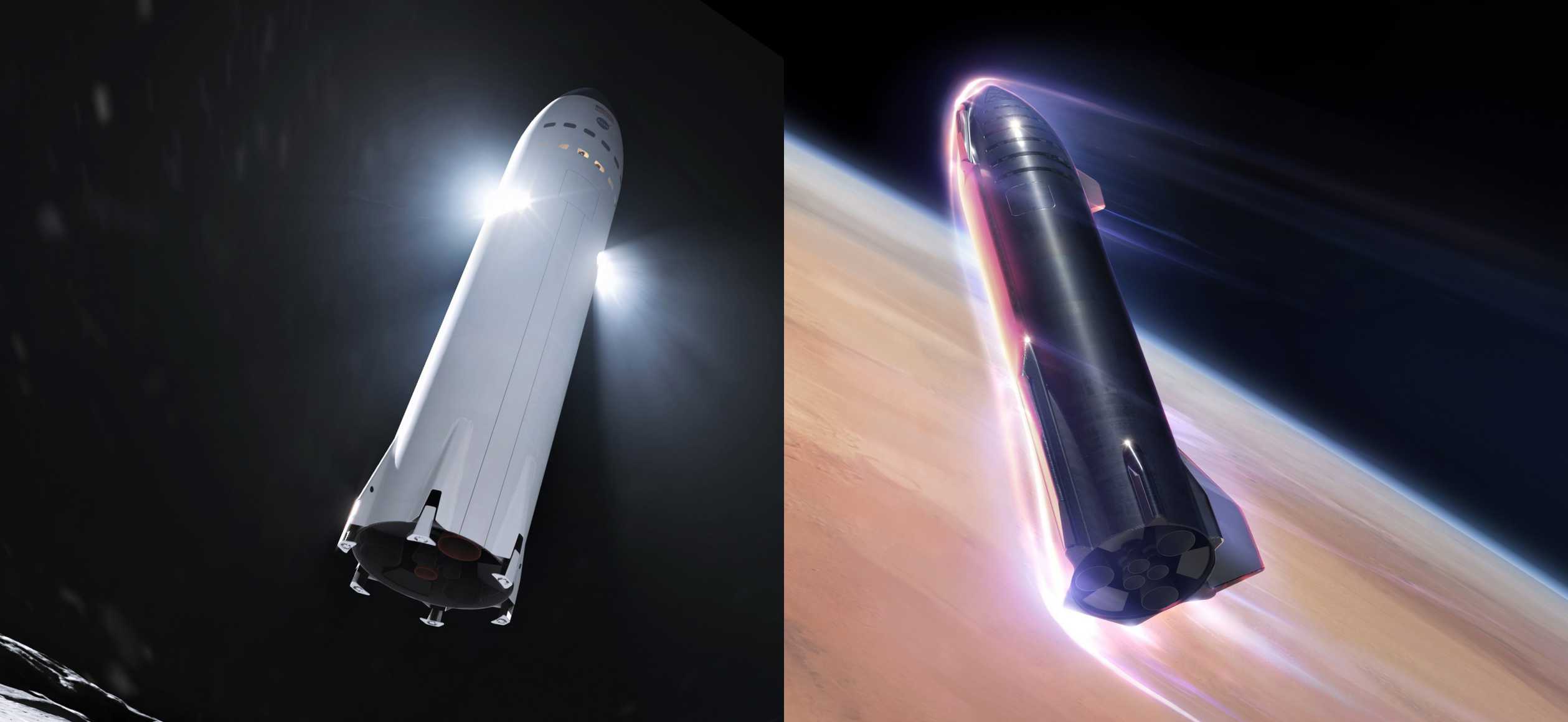

News
SpaceX’s Moon Starship is a brilliant step towards reusable Mars rockets
SpaceX’s newly-announced Moon Starship is a fairly radical departure from the Mars-focused, fully-reusable vehicle the company has been pursuing for years. Unintuitively, that may be the perfect half-step towards truly reusable Mars rockets.
On April 30th, NASA announced that SpaceX had won $135 million to design and build a highly-customized variant of its reusable Starship spacecraft with the intention of launching a handful of space agency astronauts to the Moon in the mid-2020s. Whether or not that initial seed translates into enough funding to seriously design and build the ship SpaceX has shown off in new renders, it has already broken the ice, so to speak, between the US federal government (or at least NASA) and the company’s ambitious next-generation launch vehicle.
With a substantial amount of money now on the table for SpaceX to begin initial work on its Moon Starship, it’s worth analyzing just how different it is from the Starship the company is working on today.
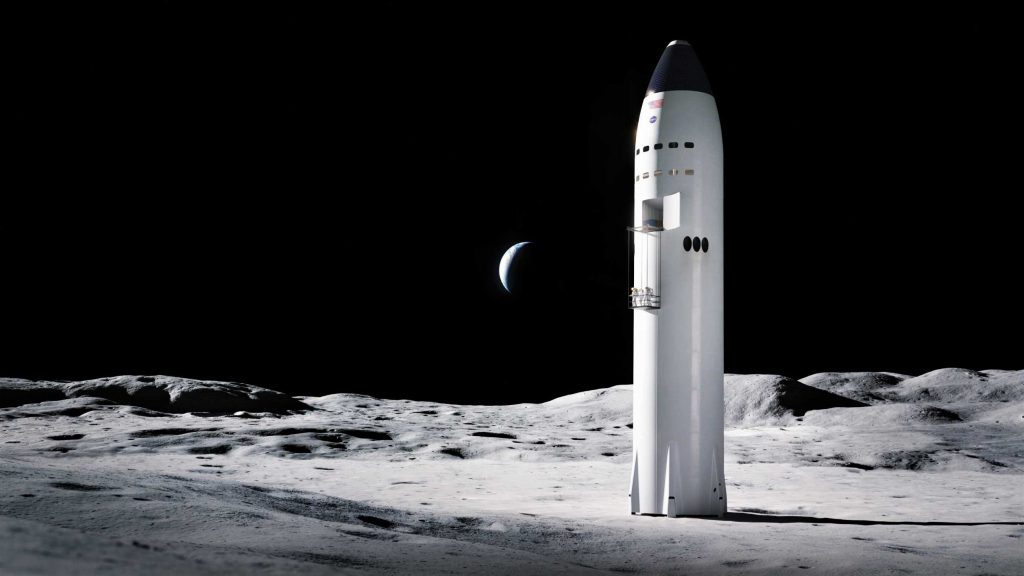
First and foremost, perhaps the most obvious difference between SpaceX’s ‘base’ Starship and its lunar variant is the rocket’s hull. In the case of the Moonbound ship, SpaceX appears to have returned to a fully-painted vehicle for unknown reasons. More likely than not, that white paint is likely motivated by the fact that proposed NASA Moon landers must (obviously) be capable of landing and safely returning their astronaut cargo back into lunar orbit.
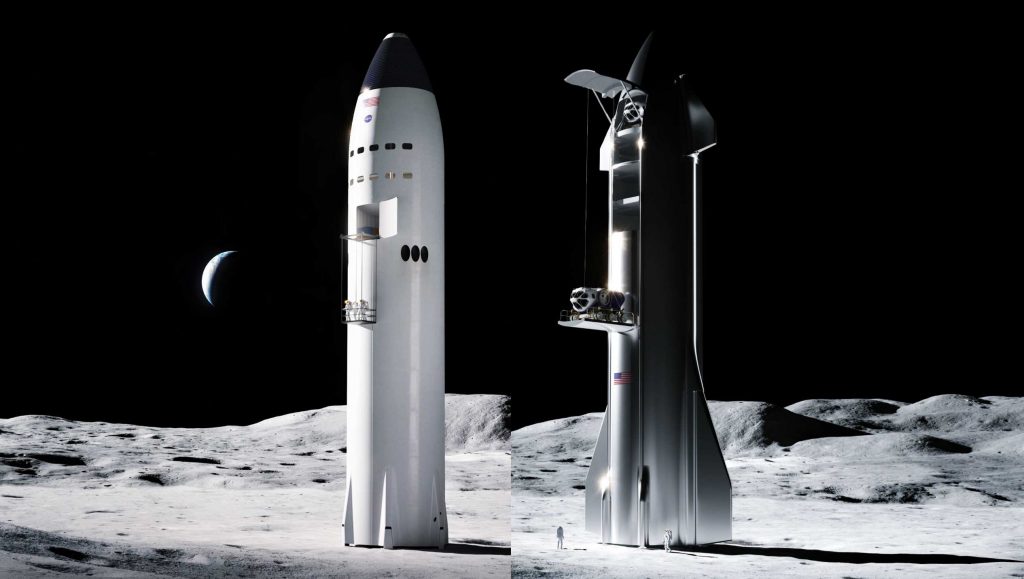
To do that, those landers must be able to sit on the surface of the Moon after landing for at least several days, with longer stays being even better. For Starship, this means that the vehicle must likely be able to keep its cryogenic liquid methane and oxygen propellant from warming up and turning into gas, thus preventing it from igniting its main Raptor engines. White paint is at least a bit more reflective (and thus insulating) compared to Starship’s shiny steel hull but it could also hint at the use of more extensive insulation then sealed off with paint.
This ties into perhaps the most significant functional change to the rocket. While visible in a render of the craft after landing on the Moon, a separate render just before touchdown fully revealed not only the addition of large vacuum-optimized retrothrusters – but a major strategic shift in how Lunar Starship will attempt to land on the Moon.
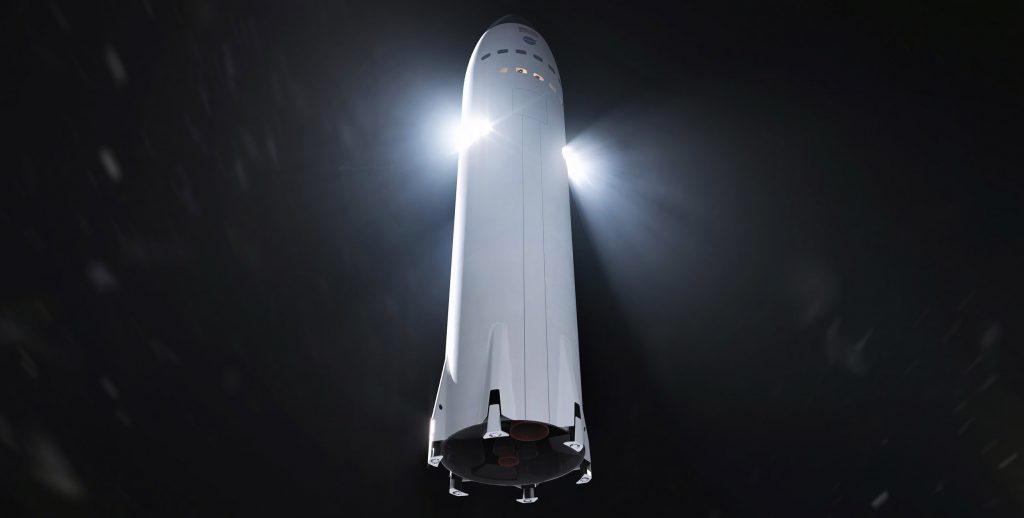
In short, it appears that SpaceX does not plan on propulsively landing Lunar Starship on the Moon under the power of its main Raptor engines. Instead, three triple-thruster clusters – likely relying on the same methane and oxygen propellant as Raptor – will fire up shortly before touchdown to gently land Starship on the Moon. This approach has significant benefits: the Moon’s gravity is so low (~1/6th of Earth’s) that using even just one engine as powerful as Raptor to land would be incredibly difficult – a single engine could theoretically lift a fully-fueled Starship thanks to low lunar gravity.
Additionally, powerful Raptor engines – even if they could be used to land – would likely dig huge craters in the Moon’s powder-like surface during a landing burn, making it more difficult astronauts to leave the ship to explore their surroundings. However, it also means that SpaceX must design and certify an entirely new kind of vacuum-optimized rocket engine – likely using gas propellant and fed by high-pressure tanks – for an extremely critical part of operations. If those landing engines were to fail, Starship would very likely crash on the Moon, marooning, wounding, or even condemning the astronauts aboard it.
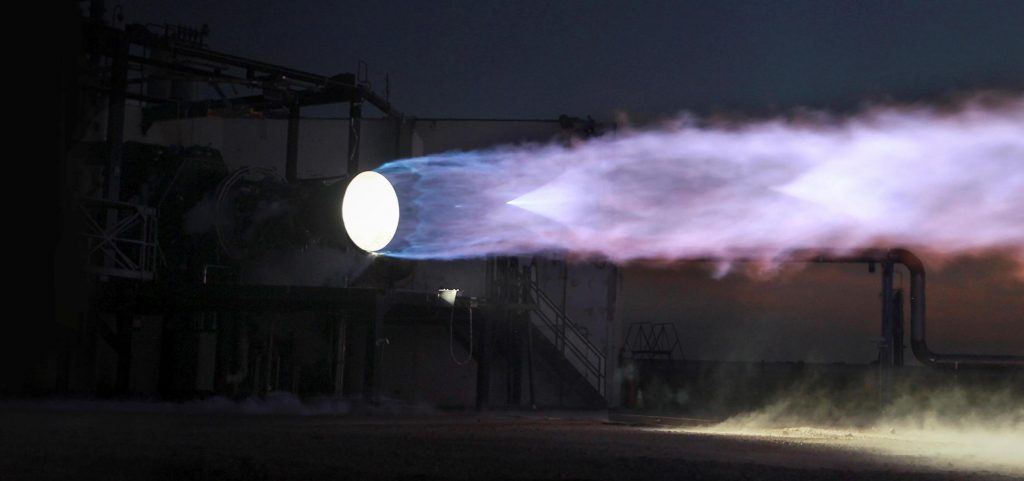
Beyond new thrusters, a radically different landing strategy, and a painted (and possibly insulated) steel hull, Lunar Starship also features what looks like the tip of a Crew Dragon spacecraft in place of its nose, likely including Draco thrusters and a docking port. SpaceX has also copied the concept of Crew Dragon’s trunk section, installing a curved solar array that wraps around a large portion of Starship’s conical nose. Lunar Starship also offers what looks like the first official glimpse into a new style of Starship landing legs, prototypes of which are already installed on Starship SN4.
Simplicity first (ish)
Additionally, SpaceX has chosen to entirely exclude a windward heat shield from Lunar Starship, as NASA’s plan is (rather painfully) to launch astronauts to the Moon with SLS and carry them to lunar orbit and back to Earth on Orion. Starship also appears to be missing its complex and extensive habitation module and massive gallery window. All that absent hardware is almost certainly meant to dramatically simplify Starship to the point that even NASA would consider funding its development. Incredibly, that strategy appears to have worked and it’s possible that we could see Lunar Starships flying to the Moon as early as 2022.
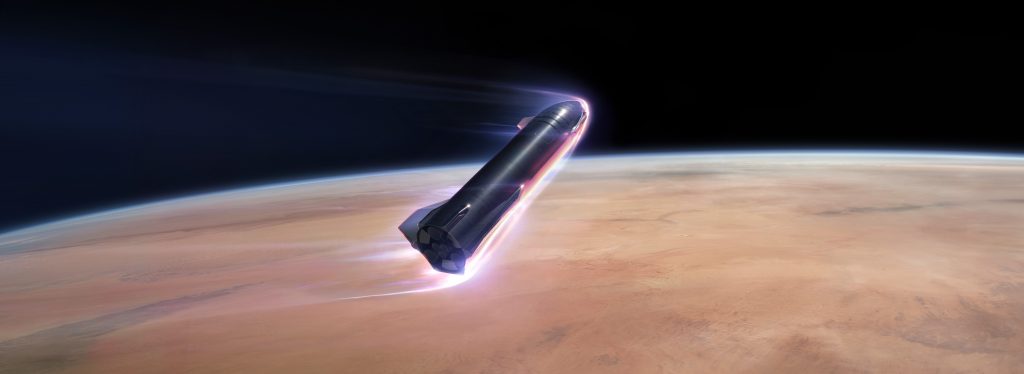
While a stop at the Moon is decidedly one-way and requires a bit of a one-off Starship variant, what SpaceX has really done is found a way to get NASA to help fund the development of its fully-reusable next-generation launch system. Even if NASA’s Artemis program dies, flounders, or goes nowhere, SpaceX will likely still benefit significantly, much in the same way that NASA’s assistance developing Cargo Dragon and Falcon 9 was a huge boon for the company.
Check out Teslarati’s Marketplace! We offer Tesla accessories, including for the Tesla Cybertruck and Tesla Model 3.
Elon Musk
Elon Musk confirms Grok 4 launch on July 9 with livestream event
The rollout will be accompanied by a livestream at 8 p.m. Pacific Time.

Elon Musk has officially confirmed that Grok 4, the latest version of xAI’s large language model, will launch on July 9. The rollout will be accompanied by a livestream at 8 p.m. Pacific Time, hosted on xAI’s official account on X.
xAI goes straight to Grok 4
Back in May, leaks indicated that xAI was getting ready to ship Grok 3.5. Considering Musk’s recent comments, however, it appears that the artificial intelligence startup would be focusing on the large language model’s fourth iteration instead. As noted in a Financial Express report, users on X have sighted references to Grok 4 in the lead up to the update’s launch, such as “grok-4-prod-mimic” and “Grok 4 Code.”
Musk’s Grok 4 announcement comes as AI competition intensifies between major players including OpenAI, Google, and xAI. With Musk’s Colossus supercomputer fully operational in Memphis, xAI appears to be accelerating its AI product roadmap.
Musk pushes Grok toward political neutrality
Grok 4’s launch also follows a recent controversy involving political bias, as noted in a CNN report. Last week, Grok responded to a user on X stating that political violence in the U.S. since 2016 had come more from the political right than the left. The chatbot noted in a later reply that its answer was based on information from sources like Reuters, the Journal of Democracy, and University of Maryland studies.
Musk stated that Grok’s response was a “major fail.” “Major fail, as this is objectively false. Grok is parroting legacy media. Working on it,” he wrote in a post on X. By the end of June, Musk noted that he was “grinding all night with the xAI team” and that they were making “good progress.” He also stated that the model “Will be called Grok 4. Release just after July 4th. Needs one more big run for a specialized coding model.”
News
Tesla opens massive solar Supercharger station in California
The Supercharger opened to customers ahead of Fourth of July weekend, while Tesla continues phase two of construction on the site.

Tesla has officially launched the first several Supercharging posts at a massive station in California, notably including solar canopies and grid-scale batteries to offer completely renewable charging.
Last week, Tesla announced on X that it opened the first 84 Supercharger stalls of a planned 168-stall station in Lost Hills, California. Additionally, the massive Supercharger project features 11MW of solar canopies and 10 Megapack batteries for off-grid charging powered entirely by solar energy.
Tesla completed the first phase of the project just days ahead of the busy Fourth of July holiday weekend, adding that initial construction took just eight months. In addition to the remaining charging stalls, Tesla says it’s building a set of lounge areas, renderings of which can be seen below alongside current photos of the site.
Notably, the site also includes V4 charging posts for the company’s latest available charging speeds, and it’s located near the busy junction between I-5 and Highway 46 in Kern County.
“Thank you [Kern County] and [PG&E] for collaboration and approvals,” Tesla wrote in a follow-up post.

Credit: Tesla Charging | X

Credit: Tesla Charging | X

Credit: Tesla Charging | X

Credit: Tesla Charging | X
Tesla Supercharger Maps for North America, Europe, and Asia pic.twitter.com/0U5r0XRPyo
— TESLARATI (@Teslarati) July 2, 2025
READ MORE ON TESLA SUPERCHARGERS: Tesla launches ultra-fast V4 Superchargers in China for the first time
Testing at the LA Diner, plus Musk update on potential Tesla solar Gigafactory
The huge Tesla Supercharger station completed phase one of construction fairly quickly, especially given how long Tesla has been working on its unique Los Angeles diner, drive-in, and Supercharger location. Still, the company was seen performing some testing at the nearly-completed charging station earlier this month, and will reportedly be holding a job fair.
Elon Musk also responded on Monday morning to a post on X, suggesting that Tesla is “thinking about” building a U.S.-based solar Gigafactory in order to help support increased power needs with AI growth, and to bolster domestic solar production.
Tesla is building a new UFO-inspired Supercharger in the heart of Alien country
News
Tesla driver walks away from major accident with minor injuries
The driver sustained only minor injuries, and the exact cause of the crash remains under investigation.

The driver of a Tesla Model Y survived and walked away from a harrowing accident on Monday in California, only sustaining minor injuries despite the vehicle being impaled by a guardrail.
On Monday morning around 4:34 a.m., the Los Banos division of the California Highway Patrol (CHP) responded to the accident on I-5 near Panoche Road, involving a 23-year-old in a Tesla Model Y. According to a post on social media, the driver veered off the road for unknown reasons in the northbound lane, before crashing directly into the guardrail and impaling the vehicle.
You can read the full message and photos from Los Banos CHP below, as were shared in a Facebook post on Monday afternoon.
This morning a Tesla model y was traveling in the #1 northbound lane of I-5 north of Panoche Rd. For unknown reasons driver allowed V-1 to veer off the roadway, travel through a dirt center divide, and crashed into the fixed metal guardrail. Lucky for the driver he only sustained minor injuries and was able to walk away. Driving a vehicle requires 100% attention to the road. Avoid distractions and focus on driving.

Credit: CHP Los Banos (via Facebook)

Credit: CHP Los Banos (via Facebook)

Credit: CHP Los Banos (via Facebook)
In a statement to SFGate, CHP officer Myles Anderson said that the driver only sustained minor injuries, while no arrests are made and drugs and alcohol are not suspected to have been involved. The report also notes that Tesla’s “cruise control and lane assistance features” were activated, according to Anderson. However, it’s not entirely clear if this is referring to Supervised Full Self-Driving (FSD), or to the cruise control and lane assist features baked into Autopilot.
At the time of writing, CHP has not yet responded to Teslarati’s request for clarification and additional details on the matter.
Tesla Crash Safety Ratings across its lineup: pic.twitter.com/ny30R7ceji
— TESLARATI (@Teslarati) July 1, 2025
READ MORE ON TESLA SAFETY: Tesla rolls out crucial new safety feature aimed at saving children
The news comes after Tesla has touted its vehicles as incredibly safe for many years. In December, for example, the company highlighted receiving top safety scores from regulators on four different continents throughout the world, including from the National Highway Traffic Safety Administration (NHTSA) and the Insurance Institute of Highway Safety (IIHS) in the U.S.
Tesla has also listed the goal of making its vehicles the safest on the road throughout the years, both in the overall design of its vehicles and in its Autopilot and Full Self-Driving (FSD) programs.
Tesla Model 3 ranks as the safest new car in Europe for 2025, per Euro NCAP tests
-

 Elon Musk1 week ago
Elon Musk1 week agoTesla investors will be shocked by Jim Cramer’s latest assessment
-

 News2 weeks ago
News2 weeks agoTesla Robotaxi’s biggest challenge seems to be this one thing
-

 News2 weeks ago
News2 weeks agoWatch the first true Tesla Robotaxi intervention by safety monitor
-

 Elon Musk1 week ago
Elon Musk1 week agoA Tesla just delivered itself to a customer autonomously, Elon Musk confirms
-

 News2 weeks ago
News2 weeks agoTesla Robotaxi rollout proves that Elon Musk still delivers, even if it’s late
-

 Elon Musk2 weeks ago
Elon Musk2 weeks agoxAI welcomes Memphis pollution results, environmental groups push back
-

 Elon Musk2 weeks ago
Elon Musk2 weeks agoElon Musk commends Tesla team on successful Robotaxi launch
-

 Elon Musk2 weeks ago
Elon Musk2 weeks agoElon Musk confirms Tesla Optimus V3 already uses Grok voice AI


















